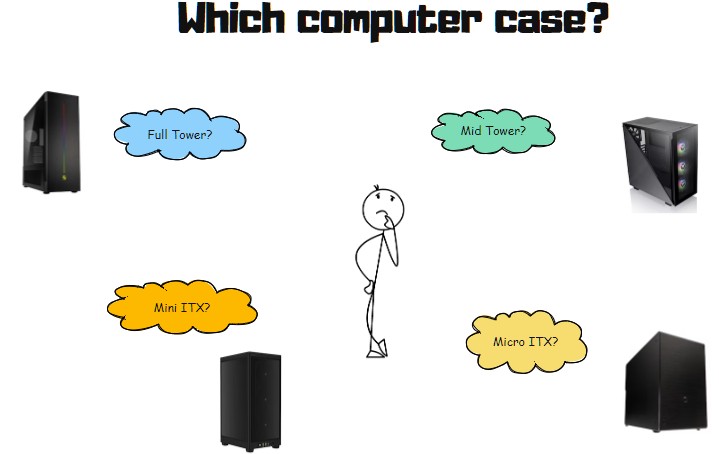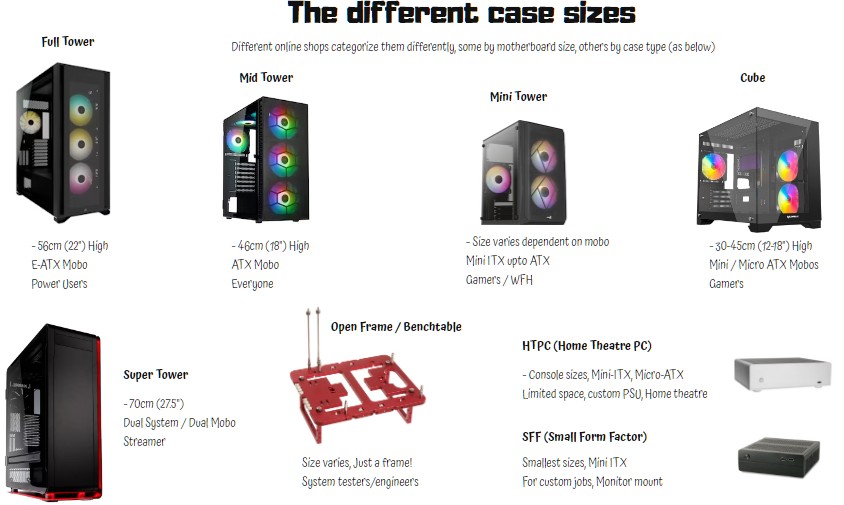Choosing a computer case
Compared to computer components, cases are relatively non technical things, this lowers the bar to entry for manufacturing them. But it also means you have a huge amount of different options available to you when picking one.
Unless you keep your computer inside a cupboard or some other enclosure, your case is one thing you’ll see day in, day out. Therefore, if you are building your own rig, it’s where you’ll probably want to spend a little time choosing something that shows off your building skills a little.

Available Case Sizes
Computer cases don’t have official size specifications that all manufacturers must adhere to. Their specs will simply tell you which sizes of motherboard they accommodate, such as ATX, E-ATX or Micro ATX.
They do, however, have categorizations that are useful when looking through online retailers and narrowing down the type of case you are looking at.
Let’s go through some of the common categories and terminology and explain what it means:
- Full Tower – A full tower case is the largest type of upstanding case, typically 56cm (22in) in height. They are the largest type of case available and support the greatest array of motherboard sizes and expansion slots. Full tower cases are ideal for enthusiast builds containing extreme cooling systems, multiple GPUs, large amounts of internal storage drives and optical drive bays and large form factor motherboards, such as E-ATX and HPTX.
- Mid Tower – Mid tower cases usually accommodate ATX sized motherboards and, like ATX motherboards are one of the most common sizes of case available. A mid tower typically stands around 46cm (18in) high and offers a medium level of mounting options that the average user will probably never exhaust.
- Mini Tower – Mini tower cases that can stand anywhere from 30 to 45 cm (12-18 in) often only accept smaller motherboards such as the Micro or even smaller Mini ITX. They offer fewer mounting options and expansion slots and often limit the size of PSU or GPU that will fit inside them.
- Cube – Cube cases (as the name suggests) are more cube shaped than the standard rectangular box shape you get with standard tower cases. You can find cube cases in many sizes designed to fit all common sizes of motherboard from E-ATX down to Mini ITX. They allow you to mount your motherboard and components horizontally to more visibly display them to the outside word or for simple space saving purposes.
- Super Tower – A large category of computer case that is often designed to accommodate 2 motherboards (one full size and one mini). Game streamers who need a full size system to game on and a secondary system for streaming content all inside a single tower often need this type of setup.
- Open Frame / Benchtable – These types of case, designed for system testers and bench markers, allow easy access to computer internals. They are usually is just a frame that offers somewhere to hold a motherboard and components with no enclosure to surround them.
- SFF – SFF or Small Form Factor cases are the smallest types of consumer case designed for ultra portability or custom mounting options (such as behind a monitor).
- HTPC – Home Theater PC cases are small form factor cases designed to integrate well as part of a home entertainment setup. They are small form factor cases that usually only accept the smallest Mini-ITX form factor motherboards, small SFX power supplies and a few drive bays.

Colors, Materials and General Aesthetics
Once mounted, you don’t want your computer components to move, so they usually make computer cases from a rigid metal frame such as steel. You can make case exteriors from almost anything that doesn’t deform when it gets warm. For this reason, you can find cases with a wide range of aesthetics.
Once upon a time, all computer cases were beige, but these days you can find them with an array of colors, but black and white are the most common.
Mesh cases vs solid cases
One of the best ways to keep a computer cooling system running well is a good supply of cool fresh air from outside the case. You’ll find some cases have mesh side panels and top panels designed to allow a straightforward path for hot air to leave and cool air to enter the case.
Mesh cases are exceptional for improving cooling with fewer fans, and they can also offer a limited view of internal components, especially if you have some components like RAM, and AIO cooler pump or GPU with LED illumination. However, they are simply not as good at containing noise as solid sided cases.
If you want a quiet build, choose a solid sided glass or metal case that allows you to remove the covers for only the fan vents you intend to use. This is the type of design you’ll find when looking for cases marketed as ‘quiet’.
Will my GPU/PSU/Cooler fit?
Modern GPUs, especially the latest high end and overclocked variants with 3x fans, can be wider than many motherboards, and they can push the limitations of space available inside cases. The same also applies to some larger ATX power supplies with longer than standard lengths and CPU air coolers with tall radiators.
It’s always worth checking your case specifications to understand any size limitations it defines for maximum lengths of GPU, power supply and height of CPU cooler.
Fans, Radiators and Drive Mounts
When considering a new computer case, you need to ensure that there are enough internal mountings for your components. An ATX mid tower case will always allow you to mount a single ATX motherboard and an ATX power supply, that’s a given, however you should ensure that there are enough internal mounts for your other components (including the cooling system).
Whilst AIO coolers use water to cool the CPU, they also need somewhere to mount a radiator and fans. AIO radiators can use 2 or even 3 fans and vary in size from 240 to 420 mm long. The recommended mounting for these radiators is vertically at the front of a tower case (as intake fans) or horizontally at the top (as exhaust fans). So you need to ensure that your case as the correct size mounts to allow at least one of these options.
An air cooled CPU will also need at least one or 2 case fans to promote a good airflow through the case. The smaller the case size, the smaller and lesser of these mounts there will be.
Do you need an accessible 5.25″ DVD or CD-ROM drive bay? Maybe you create DVDs or need to access an old library. If that’s the case, make sure that the case you choose allows for this as modern gaming cases often remove this option in favor of simply having front mounts for cooling fans or radiators instead.
How many 2.5″ SSD or 3.5″ HDD drives will you use for internal storage? If you are intending to use a RAID setup and have several drives to mount, you need to make sure that there are sufficient spaces available for you to do this. M.2 drives are a little different.
Cable routing considerations
Budget cases normally offer little in the way of cable management options and have a functional design that simply holds components in place. More expensive cases and gamer focused cases with clear or mesh side panels and front panels will often provide you with more options for routing cables behind the ‘non-visible’ side of the motherboard panel.
What is the front panel and what connectors are necessary?
All cases will come with a front panel. This is the part of the case that you interact with the most. It doesn’t have to be on the front of your case, it could be on the top, side or even under a small cover, but these connectors should be easily accessible to the user without requiring them to get behind the computer.
You will commonly find the following on the ‘front panel’ of a case:
- Power LED
- On/Off/Reset Button
- HD Audio or Headphone Jack, Microphone Jacks
- USB-A Ports
- USB-C Ports
It’s a good idea to check your motherboard manual and ensure that it lists the connections to support the ports available on any case you choose. Usually, the motherboard will place these connections on the right side (closer to the front of a typical tower case) and label them as ‘front panel’ connections in the manual.
Recommendations
Budget builders should go with the most commonly available type of case on the market, the Mid Tower ATX. There are often bargains available in this category because of the huge number of options out there.
The Mid Tower ATX is also where business professionals and creative professionals will look. You’ll have to have a pretty extreme build with a lot of internal storage to exhaust the options on these cases.
If you are a gamer, or tech enthusiast, then you’ll want to look at a Mid or Full Tower with a tempered glass side to give a view on your motherboard or even a Cube case if you have a flagship GPU you want to show off.